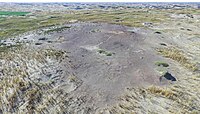Xichengyi culture
Bronze Age culture in Gansu, China, c. 900–200 BCE

-2000

EBLA
MARI
ASSYRIA
Jeul-
mun
mun
Andronovo
culture
culture
Sintashta
culture
culture
BMAC
Vakhsh
Ancient
Northeast Asians
Northeast Asians
Tarim
mummies
mummies
Okunev
Elunino
Glazkov
Karakol
Samus
Lower
Xiajiadian
Xiajiadian
Chemurchek
Seima-Turbino
culture
culture
SUMER
ELAM
INDUS
VALLEY
CIVILIZATION
VALLEY
CIVILIZATION
EGYPT
MIDDLE
KINGDOM
MIDDLE
KINGDOM
Kerma
culture
culture
Longshan
Qijia
Xichengyi
Linya
Zhukaigou
Shimao
Baodun
Shijiahe
Abashevo
Culture
Culture
Catacomb
Culture
Culture
◁ ▷
class=notpageimage|
Xichengyi culture and contemporary cultures and polities in Continental Asia
Shajing culture (800–200 BCE)[1]
Han Dynasty (202 BCE–220 CE)[1]

The Xichengyi culture (Ch:西城驿文化) was an ancient culture in the central Heihe River region of the Hexi corridor, from 2,000 to 1,600 BCE.[2] It is contemporary with the Qijia culture to its southeast. It succeeded the Majiayao culture (2,300–2,000 BCE) in the area, and preceded the Siba culture.[1]
Some of its important archaeological sites are Xichengyi, Ganggangwa (where there are also some earlier Machang culture remains), and Huoshiliang (exclusively Xichengyi culture).[2]
The Xichengyi culture practiced bronze smelting extensively, as seen by the quantity of slabs and furnace material (adobe constructions with blast pipes).[3] The copper ore was from the neighbouring Beishan Mountain.[3]
-
 Huoshiliang site, EBA 2000-1600 BCE
Huoshiliang site, EBA 2000-1600 BCE -
 Huoshiliang bronze slabs, 2000-1600 BCE
Huoshiliang bronze slabs, 2000-1600 BCE -
 Huoshiliang pottery shards, Xichenyi culture, 2000-1600 BCE
Huoshiliang pottery shards, Xichenyi culture, 2000-1600 BCE -
 Ganggangwa site
Ganggangwa site -
 Ganggangwa site pottery shards, Xichengyi culture, 2000-1600 BCE
Ganggangwa site pottery shards, Xichengyi culture, 2000-1600 BCE -
![Xichengyi adobe building and bronze slabs.[3]](//upload.wikimedia.org/wikipedia/commons/thumb/6/65/Xichengyi_adobe_building_and_bronze_slabs.png/200px-Xichengyi_adobe_building_and_bronze_slabs.png) Xichengyi adobe building and bronze slabs.[3]
Xichengyi adobe building and bronze slabs.[3] -
![Xichengyi blast pipes.[3]](//upload.wikimedia.org/wikipedia/commons/thumb/c/ce/Xichengyi_blast_pipes.png/200px-Xichengyi_blast_pipes.png) Xichengyi blast pipes.[3]
Xichengyi blast pipes.[3]
References
- ^ a b c d Li, Xin; Wei, Wenyu; Ma, Minmin; Lu, Minxia; Du, Linyao; Yang, Yishi; Chen, Guoke; Ren, Lele (2023). "Transformation of animal utilization strategies from the late Neolithic to the Han Dynasty in the Hexi Corridor, northwest China: Zooarchaeological and stable isotopic evidence". Frontiers in Earth Science. 10. Bibcode:2023FrEaS..1064803L. doi:10.3389/feart.2022.1064803. ISSN 2296-6463.
- ^ a b Qiu, Menghan; Li, Haoran; Lu, Minxia; Yang, Yishi; Zhang, Shanjia; Li, Ruo; Chen, Guoke; Ren, Lele (2022). "Diversification in Feeding Pattern of Livestock in Early Bronze Age Northwestern China". Frontiers in Ecology and Evolution. 10. doi:10.3389/fevo.2022.908131. ISSN 2296-701X.
- ^ a b c d Chen, G.; Cui, Y.; Liu, R.; Wang, H.; Yang, Y.; Pollard, A. M.; Li, Y. (October 2020). "Lead isotopic analyses of copper ores in the Early Bronze Age central Hexi Corridor, north‐west China". Archaeometry. 62 (5): 952–964. doi:10.1111/arcm.12566. hdl:21.11116/0000-0006-0FF7-4. S2CID 216443994.
- v
- t
- e
Prehistoric cultures of China
- Xinglongwa
- Xinglonggou
- Xinle
- Zhaobaogou
- Hongshan
- Xiaoheyan
- Lower Xiajiadian
- Laohushan
- (Xituanshan)
- Upper Xiajiadian
- Baijinbao
- Jinggouzi
- Liaoning bronze dagger
- Pengtoushan
- Chengbeixi
- Daxi
- Tangjiagang
- Qujialing
- Shijiahe
- Baodun
- Sanxingdui
- Erligang
- Feijiahe
- (Zengpiyan)
- Shixia
- Wucheng
- Fanchengdui
- Karuo
- Qugong
 History
History Archaeology
Archaeology History
History





![Xichengyi adobe building and bronze slabs.[3]](http://upload.wikimedia.org/wikipedia/commons/thumb/6/65/Xichengyi_adobe_building_and_bronze_slabs.png/200px-Xichengyi_adobe_building_and_bronze_slabs.png)
![Xichengyi blast pipes.[3]](http://upload.wikimedia.org/wikipedia/commons/thumb/c/ce/Xichengyi_blast_pipes.png/200px-Xichengyi_blast_pipes.png)













